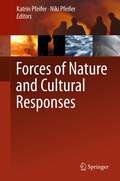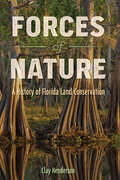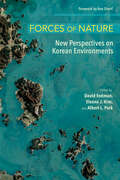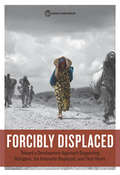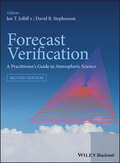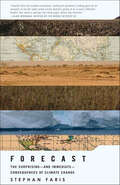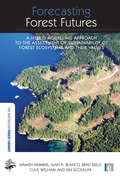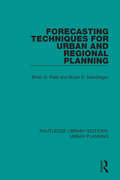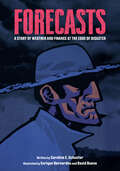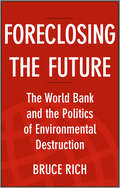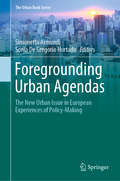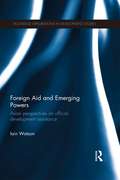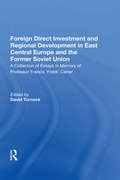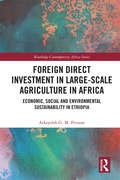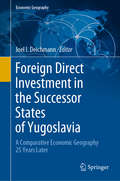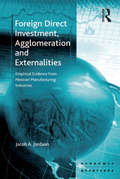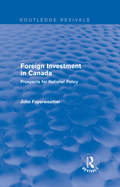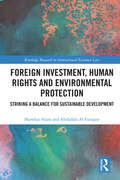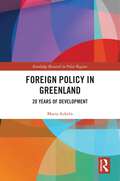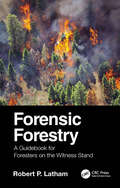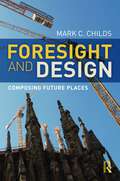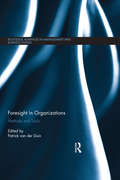- Table View
- List View
Forces of Nature and Cultural Responses
by Katrin Pfeifer Niki PfeiferHow do and how did people perceive, manage and respond to natural disasters? How are the causes of natural disasters explained in history, how are they explained today? This volume investigates relationships between forces of nature and human culture in a multidisciplinary context bridging science and the humanities. Forces of nature and cultural responses is divided into four sections: (1) ball lightnings, (2) earthquakes and tsunamis, (3) volcanic eruptions and plagues, and (4) hurricanes and floodings. Specifically, Section 1 investigates theories and case studies of ball lightning phenomena. Section 2 includes a psychological study on the impact of earthquakes on academic performance, a study on tsunami vulnerability and recovery strategies in Thailand and a study on the social and economic aftermaths of a tsunami and a hurricane in Hawaii. Section 3 consists of a chapter on volcanic eruptions and plagues as well as cultural responses in Ancient Times and a study on contemporary vulnerability and resilience under chronic volcanic eruptions. Section 4 investigates the impact of hurricane Katrina on the current jazz scene in New Orleans and cultural responses to floodings in The Netherlands in Early Modern Times.
Forces of Nature and Cultural Responses
by Katrin Pfeifer Niki PfeiferHow do and how did people perceive, manage and respond to natural disasters? How are the causes of natural disasters explained in history, how are they explained today? This volume investigates relationships between forces of nature and human culture in a multidisciplinary context bridging science and the humanities.Forces of nature and cultural responses is divided into four sections: (1) ball lightnings, (2) earthquakes and tsunamis, (3) volcanic eruptions and plagues, and (4) hurricanes and floodings. Specifically, Section 1 investigates theories and case studies of ball lightning phenomena. Section 2 includes a psychological study on the impact of earthquakes on academic performance, a study on tsunami vulnerability and recovery strategies in Thailand and a study on the social and economic aftermaths of a tsunami and a hurricane in Hawaii. Section 3 consists of a chapter on volcanic eruptions and plagues as well as cultural responses in Ancient Times and a study on contemporary vulnerability and resilience under chronic volcanic eruptions. Section 4 investigates the impact of hurricane Katrina on the current jazz scene in New Orleans and cultural responses to floodings in The Netherlands in Early Modern Times.
Forces of Nature: A History of Florida Land Conservation
by Clay HendersonThe activists and victories that made Florida a leader in land preservation Despite Florida’s important place at the beginning of the American conservation movement and its notable successes in the fight against environmental damage, the full story of land conservation in the state has not yet been told. In this comprehensive history, Clay Henderson celebrates the individuals and organizations who made the Sunshine State a leader in state-funded conservation and land preservation. Starting with early naturalists like William Bartram and John Muir who inspired the movement to create national parks and protect the country’s wilderness, Forces of Nature describes the efforts of familiar heroes like Marjory Stoneman Douglas and May Mann Jennings and introduces lesser-known champions like Frank Chapman, who helped convince Theodore Roosevelt to establish Pelican Island as the first national wildlife refuge in the United States. Henderson details how many of Florida’s activists, artists, philanthropists, and politicians have worked to designate threatened land for use as parks, preserves, and other conservation areas.Drawing on historical sources, interviews, and his own long career in environmental law, Henderson recounts the many small victories over time that helped Florida create several units of the national park system, nearly thirty national wildlife refuges, and one of the best state park systems in the country. Forces of Nature will motivate readers to join in defending Florida’s natural wonders.
Forces of Nature: New Perspectives on Korean Environments (The Environments of East Asia)
by David Fedman, Eleana J. Kim, and Albert L. ParkBringing together a multidisciplinary conversation about the entanglement of nature and society in the Korean peninsula, Forces of Nature aims to define and develop the field of the Korean environmental humanities. At its core, the volume works to foreground non-human agents that have long been marginalized in Korean studies, placing flora, fauna, mineral deposits, and climatic conditions that have hitherto been confined to footnotes front and center. In the process, the authors blaze new trails through Korea's social and physical landscapes.What emerges is a deeper appreciation of the environmental conflicts that have animated life in Korea. The authors show how natural processes have continually shaped the course of events on the peninsula—how floods, droughts, famines, fires, and pests have inexorably impinged on human affairs—and how different forces have been mobilized by the state to variously, control, extract, modernize, and showcase the Korean landscape. Forces of Nature suggestively reveals Korea's physical landscape to be not so much a passive context to Korea's history, but an active agent in its transformation and reinvention across centuries.This book is freely available in an open access edition through the generous support of the Henry Luce Foundation.
Forcibly Displaced: Toward a Development Approach Supporting Refugees, the Internally Displaced, and Their Hosts
by World BankThe Syrian refugee crisis has galvanized attention to one of the world’s foremost challenges: forced displacement. The total number of refugees and internally displaced persons, now at over 65 million, continues to grow as violent conflict spikes.This report, Forcibly Displaced: Toward a Development Approach Supporting Refugees, the Internally Displaced, and Their Hosts, produced in close partnership with the United Nations High Commissioner for Refugees (UNHCR), attempts to sort fact from fiction to better understand the scope of the challenge and encourage new thinking from a socioeconomic perspective. The report depicts the reality of forced displacement as a developing world crisis with implications for sustainable growth: 95 percent of the displaced live in developing countries and over half are in displacement for more than four years. To help the displaced, the report suggests ways to rebuild their lives with dignity through development support, focusing on their vulnerabilities such as loss of assets and lack of legal rights and opportunities. It also examines how to help host communities that need to manage the sudden arrival of large numbers of displaced people and that are under pressure to expand services, create jobs, and address long-standing development issues. Critical to this response is collective action. As work on a new Global Compact on Responsibility Sharing for Refugees progresses, the report underscores the importance of humanitarian and development communities working together in complementary ways to support countries throughout the crisis†•from strengthening resilience and preparedness at the onset to creating lasting solutions.
Forecast Verification
by Ian T. Jolliffe David B. StephensonForecast Verification: A Practioner's Guide in Atmospheric Science, 2nd Edition provides an indispensible guide to this area of active research by combining depth of information with a range of topics to appeal both to professional practitioners and researchers and postgraduates. The editors have succeeded in presenting chapters by a variety of the leading experts in the field while still retaining a cohesive and highly accessible style. The book balances explanations of concepts with clear and useful discussion of the main application areas.Reviews of first edition:"This book will provide a good reference, and I recommend it especially for developers and evaluators of statistical forecast systems." (Bulletin of the American Meteorological Society; April 2004)"...a good mixture of theory and practical applications...well organized and clearly written..." (Royal Statistical Society, Vol.168, No.1, January 2005)NEW to the second edition:Completely updated chapter on the Verification of Spatial Forecasts taking account of the wealth of new research in the area New separate chapters on Probability Forecasts and Ensemble Forecasts Includes new chapter on Forecasts of Extreme Events and Warnings Includes new chapter on Seasonal and Climate Forecasts Includes new Appendix on Verification Software Cover image credit: The triangle of barplots shows a novel use of colour for visualizing probability forecasts of ternary categories - see Fig 6b of Jupp et al. 2011, On the visualisation, verification and recalibration of ternary probabilistic forecasts, Phil. Trans. Roy. Soc. (in press).
Forecast: The Surprising—and Immediate—Consequences of Climate Change
by Stephan FarisA vivid and illuminating portrayal of the surprising ways that climate change will affect the world in the near future—politically, economically, and culturallyWhile reporting just outside of Darfur, Stephan Faris discovered that climate change was at the root of that conflict, and began to wonder what current and impending—and largely unanticipated—crises such changes have in store for the world. Forecast provides the answers.Global warming will spur the spread of many diseases. Italy has already experienced its first climate-change epidemic of a tropical disease, and malaria is gaining ground in Africa. The warming world will shift huge populations and potentially redraw political alliances around the globe, driving environmentalists into the hands of anti-immigrant groups. America's coasts are already more difficult places to live as increasing insurance rates make the Gulf Coast and other gorgeous spots prohibitively expensive. Crops will fail in previously lush places and thrive in some formerly barren zones, altering huge industries and remaking traditions. Water scarcity in India and Pakistan have the potential to inflame the conflict in Kashmir to unprecedented levels and draw the United States into the troubles there, and elsewhere.Told through the narratives of current, past, and future events, the result of astonishingly wide travel and reporting, Forecast is a powerful, gracefully written, eye-opening account of this most urgent issue and how it has altered and will alter our world.
Forecasting Forest Futures: A Hybrid Modelling Approach to the Assessment of Sustainability of Forest Ecosystems and their Values
by Kim Scoullar Brad Seely Clive Welham Hamish Kimmins Juan A. BlancoModelling is an important tool for understanding the complexity of forest ecosystems and the variety of interactions of ecosystem components, processes and values. This book describes the hybrid approach to modelling forest ecosystems and their possible response to natural and management-induced disturbance. The book describes the FORECAST family of ecosystem management models at three different spatial scales (tree, stand and landscape), and compares them with alternative models at these three spatial scales. The book will help forest managers to understand what to expect from ecosystem-based forest models; serve as a tool for use in teaching about sustainability, scenario analysis and value trade-offs in natural resources management; and assist policy makers, managers and researches working in assessment of sustainable forest management and ecosystem management. Several real-life examples of using the FORECAST family of models in forest management and other applications are presented from countries including Canada, China, Spain and the USA, to illustrate the concepts described in the text. The book also demonstrates how these models can be extended for scenario and value trade-off analysis through visualization and educational or management games.
Forecasting Techniques for Urban and Regional Planning (Routledge Library Editions: Urban Planning #11)
by Brian FieldOriginally published in 1987, Forecasting Techniques for Urban and Regional Planning is an introduction to the various analytical techniques which have been developed and applied in urban and regional analysis in planning practice. The subjects covered are population, housing, employment, transport, shopping, recreation, and integrated forecasting. Each technique, placed in the context of policy formulation and political matters, is presented both verbally and mathematically, and it separating characteristic is illustrated with detailed but simple practical examples. The techniques examined are set in a policy context and their practical limitations are identified.
Forecasting!
by Kris HirschmannDiscusses the history of forecasting and introduces the tools scientists use to predict weather.
Forecasts: A Story of Weather and Finance at the Edge of Disaster (ethnoGRAPHIC)
by Caroline SchusterBased in the agrarian world of commercial sesame farming in northern Paraguay, Forecasts tells a story about what happens when global insurance companies promise financial safety nets to local farmers struggling with the effects of climate change. This striking graphic novel brings together original ethnographic research and Paraguayan gothic art to confront the limitations of finance to respond to a deteriorating environment. Taking a human-centered approach to complex weather and financial models, Forecasts offers new ways of looking at overlapping speculative futures in a more-than-human landscape. Based on more than a year of fieldwork in Paraguay, the book follows one man’s possible journeys through a season of planting and harvesting, buffeted by losses and sustained by the hope that he can cultivate conditions that will help his family thrive. Forecasts makes a sweeping account of environmental and financial risk accessible through the intimate story of one family’s triumphs, heartbreaks, and hopes for the future.
Foreclosing the Future
by Bruce RichWorld Bank President Jim Yong Kim has vowed that his institution will fight poverty and climate change, a claim that World Bank presidents have made for two decades. But if worldwide protests and reams of damning internal reports are any indication, too often it does just the opposite. By funding development projects and programs that warm the planet and destroy critical natural resources on which the poor depend, the Bank has been hurting the very people it claims to serve. What explains this blatant contradiction? If anyone has the answer, it is arguably Bruce Rich—a lawyer and expert in public international finance who has for the last three decades studied the Bank’s institutional contortions, the real-world consequences of its lending, and the politics of the global environmental crisis. What emerges from the bureaucratic dust is a disturbing and gripping story of corruption, larger-than-life personalities, perverse incentives, and institutional amnesia. The World Bank is the Vatican of development finance, and its dysfunction plays out as a reflection of the political hypocrisies and failures of governance of its 188 member countries. Foreclosing the Future shows how the Bank’s failure to address the challenges of the 21st Century has implications for everyone in an increasingly interdependent world. Rich depicts how the World Bank is a microcosm of global political and economic trends—powerful forces that threaten both environmental and social ruin. Rich shows how the Bank has reinforced these forces, undercutting the most idealistic attempts at alleviating poverty and sustaining the environment, and damaging the lives of millions. Readers will see global politics on an increasingly crowded planet as they never have before—and come to understand the changes necessary if the World Bank is ever to achieve its mission.
Foregrounding Urban Agendas: The New Urban Issue in European Experiences of Policy-Making (The Urban Book Series)
by Simonetta Armondi Sonia De Gregorio HurtadoThis book highlights the discontinuities and the ongoing development of the urban question in policy-making in the context of the controversial current issues of global reversal and regional revival. It critically examines contemporary public policies and practices at the urban, regional and national scales in order to offer a timely contribution to the debate on the significance of the urban dimension and interpretation in terms of the theory, policy and practice of social-spatial research in the twenty-first century. Focusing on Europe, it explores the current urban policy agendas at different scales - and the mobility of those agendas -, their implications, contradictions and controversies. It brings together original contributions from multiple disciplines but with an urban perspective, including empirical case studies and critical discussions of the following topics:the UN 2030 Agenda for Sustainable Development, the global “New Urban Agenda” as part of the Habitat III process;the Urban Agenda for the European Union;national spatial policies related to urban agendas;urban agendas at regional/urban levels;city regionalism discourse and state rescaling;new formal regional and metropolitan governments as a solution (or problem);the role of new actors in regional urbanization dynamics; multi-level governance processes in developing an urban agenda; informal assemblages at the metropolitan scale aiming at constructing the urban concept and dimension.Given its scope, the book is of interest to urban, regional and EU policy-makers, scholars and students working in the fields of urban geography, urban studies, EU urban and regional policies, and planning.
Foreign Aid and Emerging Powers: Asian Perspectives on Official Development Assistance (Routledge Explorations in Development Studies)
by Iain WatsonCurrent debates on emerging powers as foreign aid donors often fail to examine the myriad geopolitical, geoeconomic and geocultural tensions that influence policies of Official Development Assistance (ODA). This book advocates a regional geopolitical approach to explaining donor-donor relationships and provides a multidisciplinary critical assessment of the contemporary debates on emerging powers and foreign aid, bringing together economic and geopolitical approaches in the light of the 2015 completion of the Millennium Development Goals (MDGs). Moving away from established debates assessing the advantages and disadvantages of foreign aid, this book challenges the current geopolitical assumptions of the emerging powers concerning issues such as 'south-south' solidarity, shared development experience and 'multipolarity'. It analyses how donor governments 'sell' aid to recipients through enabling different cultural assumptions and soft power narratives of national identity and provides empirical evidence on agendas such as aid effectiveness, aid for trade, public-private partnerships, and green growth aid. The book examines the role of, and relationships between, the leading traditional and emerging power Asian donors specifically, and explores the different and contested perspectives and patterns of ODA policy through an alternative account of emerging power foreign aid to leading African and Asian recipients. This book provides a valuable resource for postgraduate students and practitioners across disciplines such as development economics and geopolitics of development, uniquely approaching the debate from the perspective of emerging powers and donors.
Foreign Direct Investment and Regional Development in East Central Europe and the Former Soviet Union: A Collection of Essays in Memory of Professor Francis 'Frank' Carter (Ashgate Economic Geography Ser.)
by David TurnockWith the achievement of further EU and NATO enlargement, a critical political and economic lens is now focused on East Central Europe and, to a lesser extent, the other former communist states. Economic growth in each transition state - and more broadly the region - pivots around the prospects for foreign direct investment (FDI), with decisions on where foreign investors will locate their projects now vitally important. This book - the first one devoted to a geographical survey concentrating specifically on FDI in the region - brings together a wide range of prominent authors from the US and Europe, including the late Frank Carter, to provide a timely and critical examination of the importance of foreign investment. It presents a detailed analysis of location patterns and their significance for regional development, with particular emphasis given to the important socioeconomic and political consequences of uneven distribution of FDI across the region and its constituent countries. Divided into two parts, the book first deals with general overarching themes and issues before applying these to more specific country case studies. The second part deals with regional studies, focusing broadly on the Western Balkans and Bulgaria, before looking at specific economic sectors in individual countries.
Foreign Direct Investment in Large-Scale Agriculture in Africa: Economic, Social and Environmental Sustainability in Ethiopia (Routledge Contemporary Africa)
by Atkeyelsh G. PerssonThis book examines environmental sustainability and inclusive economic growth, providing in-depth analysis of foreign direct investment (FDI) in large-scale agriculture in Ethiopia. In most African states, arable land and other natural resources play a pivotal role for economic growth and development. Ethiopia is one of those countries where agriculture is the backbone of the economy. This sector has also been an attraction for FDI in Sub-Saharan Africa since the global food and financial crisis of 2007 and 2008. This book uses six foreign investments in large-scale agriculture as case studies to examine current Ethiopian policies, the patterns of investment they promote, how these impact on land-based resources and communities’ wellbeing. Presenting analyses of the economic, social and political realities of foreign direct investment in the local context, Foreign Direct Investment in Large-Scale Agriculture in Africa discusses how the fundamental principles of pro-poor and environmentally sustainable investments intersect with the government’s ambition to advance Ethiopia’s development agenda. This book will be of interest to scholars and students of African economics and sustainable development, African policy makers, intergovernmental organisations as well as multilateral and bilateral development partners.
Foreign Direct Investment in the Successor States of Yugoslavia: A Comparative Economic Geography 25 Years Later (Economic Geography)
by Joel I. DeichmannThis edited volume offers a descriptive analysis of foreign direct investment (FDI) flows and cumulative stock, industrial composition, and important spatial trends for each successor state of former Yugoslavia: Bosnia & Herzegovina, Croatia, Kosovo, Montenegro, North Macedonia, Serbia, and Slovenia. The chapters are written by academic experts on the topic from each of these countries and are organised systematically in order to facilitate comparison between the states. The aim of this book is to advance scholarly knowledge about FDI in Southeastern Europe 25 years after the dissolution of Yugoslavia. Each chapter includes a summary of scholarly contributions published on the topic in English-language and local language journals, a discussion of origins, composition by industry, and location choice within the country from 1995-2018, using Dunning's (1980) eclectic paradigm as a discussion framework. The chapters conclude with prospects for FDI over the next twenty-five years with emphasis on economic growth projections, EU integration, and other relevant country-specific considerations the local authors deem relevant. Special attention is given to specific companies operating in Yugoslavia prior to its breakup and how these firms have been impacted by dissolution, recession, efforts toward European Union membership. The authors also examine the past and potential impact of FDI from unforeseen events such as the Global Financial Crisis and COVID-19. This book appeals to scholars of geography, international business, economics, and economic history of the former Yugoslavia as well as professionals working in the region and on related topics elsewhere.
Foreign Direct Investment, Agglomeration and Externalities: Empirical Evidence from Mexican Manufacturing Industries (Economic Geography Series)
by Jacob A. JordaanBy critically appraising current theories of both Foreign Direct Investment (FDI) and agglomeration, this book explores the variety of links that exist between these two externality-creating phenomena. Using in-depth empirical research on Mexico, Jacob Jordaan constructs and analyzes several datasets on Mexican manufacturing industries at various geographical scales, creating innovative models on FDI externalities that incorporate explicitly regional considerations. The empirical findings identify both direct FDI spillover effects as well as the effects of agglomeration on these externalities. In extension of this, the analysis also contains analysis of FDI productivity effects that arise through inter-firm linkages between FDI and local Mexican suppliers.
Foreign Investment in Canada: Prospects for National Policy (Routledge Revivals)
by John FayerweatherThis title was first published in 1973: Why do some states enact stronger pollution control progammes than others? And, do stronger controls have identifiable impacts on environmental quality in these states? This work seeks to answer these question by means of combining data, methods and theory from the natural and social sciences.
Foreign Investment, Human Rights and Environmental Protection: Striking a Balance for Sustainable Development (Routledge Research in International Economic Law)
by Shawkat Alam Abdullah Al FaruqueThis book examines the integration of human rights and environmental standards within international investment agreements (IIAs). It explores the intricate relationship between foreign direct investment and sustainable development, emphasizing the necessity for reform in investment treaties to ensure they support rather than hinder human rights and environmental protection.The book begins with an overview of the current international investment law landscape, focusing on its primary goal of investment protection. It then delves into how human rights and environmental standards can shape IIAs, suggesting a new approach to these treaties. The authors explore the incorporation of sustainable development principles into IIAs, the difficulty of balancing investor protection with state regulatory autonomy, and the evolving norms and standards in this area. The book includes detailed case studies on topics such as the interplay between labour standards, investment, and human rights, bilateral investment agreements, sustainable forest management, and the liberalization of water services.Aimed at policymakers, legal scholars, and international law practitioners, this book provides a thorough framework for understanding and reforming IIAs. It offers groundbreaking insights into aligning investment treaties with global sustainable development goals, making it a vital resource for anyone interested in the intersection of investment, human rights, and environmental sustainability.
Foreign Policy in Greenland: 20 Years of Development (Routledge Research in Polar Regions)
by Maria AckrénForeign Policy in Greenland will shed light on what kind of competences Greenland has in IR and how Greenland undertakes foreign policy, while still being a self-governing territory underneath Danish jurisdiction. Even though Denmark has the ultimate power when it comes to foreign- and security policy, Greenland has received more autonomy in this field in recent years. Back in 1995 a permanent Danish/Greenlandic official group was established to discuss all foreign- and security matters that wererelated to Greenland. In 2003, Greenland and Denmark signed a joint declaration in Itilleq regarding the Greenlandic involvement in international affairs. Since then, the Government of Greenland has written a foreign policy report every year to outline the activities of Greenlandic international relations. This book will undertake a systematic analysis of the foreign policy papers since 2003 (or earlier) and onwards. What kind of activities have Greenland undertaken in international affairs? What are the objectives? Can Greenland be an influential player in international relations? How far is the self-government stretched or limited in relation to international relations?This book will be of interest for those with an interest in international affairs and law as well as those with an interest in international politics and foreign policy.
Forensic Forestry: A Guidebook for Foresters on the Witness Stand
by Robert P. LathamForensic Forestry: A Guidebook for Foresters on the Witness Stand is a one-of-a-kind, hands-on resource for those forestry and land use professionals called upon to work on legal cases and testify in court. Land use and forestry issues in the United States, in particular—and likewise around the world—have become increasingly contentious, scrutinized, and debated. There is little to suggest that conflicts over forestlands will cease in the near future, in fact, quite the opposite. There are already a number of informative books available on land use and forestry, and related issues under the broader heading of environmental science. As such, while this book will not go into these concepts in detail, if someone is already an expert in land use and forestry, this book will tell them the ins and outs of the legal system and how they can best serve to make a case, using evidence, in a court of law. Coverage addresses the necessary background, and legwork involved, in providing technical expertise for such cases to be adjudicated. Since professionals’ expertise is often focused on ecological issues, chapters look at the economic factors and how money, policy, and corporate interests come into play—the crux of where the professional forester’s ability to present evidence and expertise becomes critical. The author provides an overall understanding of the courts, and the legal process. Coverage includes recommendations to professionals working on cases—and in the courtroom—in how to present evidence and testify in cases over land use and forestland rights, forestry management and safety, criminal and civil cases in liability in forest fires—among myriad others. Key Features: A book by a professional for professionals in the field of forestry and those called to testify in cases of forest and wildfires, eminent domain, land disputes, tort, and liability cases Written in easy-to-read, non-technical jargon to provide tools to best serve as an expert witness and consultant to support attorneys in civil and criminal cases Details unique, real-world cases study examples, detailing how they were adjudicated based on evidence and testimony provided Presents a legal background into the court system, courtroom procedure, the types of legal cases as they relate to forensic forestry As such, Forensic Forestry is a welcome addition to those professionals called upon to consult on, and testify in, such cases including land use professionals, foresters and forestry managers, ecologists, environmentalists, environmental policy advocates, and those in related fields.
Forensic Seismology and Nuclear Test Bans
by Alan DouglasWith the signing in 1996 of the Comprehensive Nuclear Test Ban Treaty, interest has grown in forensic seismology: the application of seismology to nuclear test ban verification. This book, based on over 50 years of experience in forensic seismology research, charts the development of methods of seismic data analysis. Topics covered include: the estimation of seismic magnitudes, travel-time tables and epicentres; seismic signal processing; and the use of seismometer arrays. Fully illustrated with seismograms from explosions and earthquakes, the book demonstrates methods and problems of visual analysis. Each chapter provides exercises to help the reader familiarise themselves with practical issues in the field of forensic seismology, and figures and solutions to exercises are also available online. The book is a key reference work for academic researchers and specialists in the area of forensic seismology and Earth structure, and will also be valuable to postgraduates in seismology and solid earth geophysics.
Foresight and Design: Composing Future Places
by Mark C. ChildsEvery plan, pro-forma, design, building contract, and construction schedule is a proposal about future places. To help improve such proposals, Foresight and Design: Composing Future Places presents conceptual tools to inform design and outline the need for designers to rigorously think about potential futures. Our built compositions are constantly transforming due to continuing urbanization, demographic shifts, climate change, the evolution of virtual worlds, economic and health disparities, and other unforeseen trends. If we envision and plan for alternative futures, we are better able to purposefully respond. This book presents emerging practices of foresight, including signals of change, thick descriptions, pace layers, (re)framing, prototyping, scenarios, maps of change, storytelling, and world-building, to indicate how robust contemplation of multiple potential futures can help us compose places that are durable, resilient, and adaptable. Five brief case studies interspersed between the chapters serve as examples of practitioners exercising foresight through these practices. Contributions include a description of a regional design process in Afghanistan by Anthony Fettes of Sasaki Architects, and an exploration into the Indigenous Futurism model-making competition by Anjelica Gallegos. Written for architects, designers, planners, developers, city councilmembers, and engineers, this book encourages all composers of the built environment to envision alternative futures and purposefully respond.
Foresight in Organizations: Methods and Tools (Routledge Advances in Management and Business Studies)
by Patrick van der DuinForesight for Organizations will acquaint the reader with various foresight methods and tools, to show the reader how these methods are used, what the pitfalls are and how the methods relate to each other. This innovative volume offers the reader the ability to carry out a study of the future by him- or herself and apply the results in a decision-making strategy process. The author addresses the following methods: scenarios, trend analysis, the Delphi method, quantitative trend extrapolation, technology assessment, backcasting and roadmapping; the most relevant and popular methods that also cover the range of approaches from predictive, via normative to explorative. Every chapter also contains references to additional literature about the methods being discussed. This book is essential reading for researchers, academics and students in the areas of Community Development, Sociology of organizations, Change management, Social entrepreneurship, Sustainable development and participative planning.
